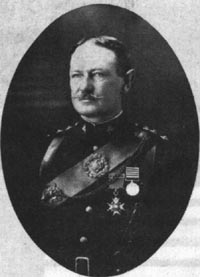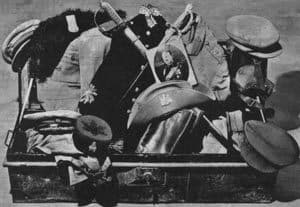
JAMES ALEXANDER KENNETH MACKAY (1859-1935), soldier, author and politician, was born on 5 June 1859 at Wallendbeen, New South Wales, son of Scottish-born parents, Alexander Mackay, squatter, and his wife Annie, nee Mackenzie; Donald George (q.v) was his brother. He was educated at home and at Camden College and Sydney Grammar School. In his mid-twenties he extended his education by attending H. E. Southey’s college at Mittagong. He was a good athlete and an outstanding horseman, well-known in country districts as an amateur jockey. He also rode at Randwick and Rosehill.
In 1885, while at Mittagong, Mackay raised a volunteer cavalry troop called the West Camden Light Horse and was appointed captain in command. Shortly afterwards he returned to the family property to assist his ageing father. He spent his quieter moments writing short stories and ballads. Several were published in newspapers and popular journals before his first book, Stirrup Jingles (1887). Similar publications in Sydney, A Bush Idyll (1888) and Songs of a Sunlit Land (1908), followed. He also wrote the novels, Out-Back (London, 1893) and The yellow Wave (1895), which imagined a Chinese invasion of Australia.
On 13 March 1890, he married Mabel Kate White at the Presbyterian manse, North Melbourne.
Mackay was elected as a Protectionist to the Legislative Assembly for Boorowa in 1895; he held the seat for (Sir) Edmund Barton’s National Federal Party in 1898. Vice President of the Executive Council in (Sir) William Lynes Ministry from 15 September 1899, he was nominated to the Legislative Council in October to represent the government. He held the same position under (Sir) John See and Thomas Waddell in 1903-04 and remained in the council until its reconstruction in 1933.
In 1897 the unpaid volunteer component of the New South Wales Military Forces was being revived. Mackay raised the 1st Australian Horse, a regiment of cavalry recruited entirely from country districts, was appointed to command and in 1898, was promoted lieutenant-colonel. A composite squadron from the regiment was sent to the South African War but Mackay was too senior in rank to accompany it. Instead, resigning his portfolio, he was given command of the New South Wales Imperial Bushmens Contingent which sailed from Sydney in April 1900. The Bushmen were sent to Rhodesia and placed under the command of Sir Frederick Carrington. They moved to Mafeking in July and into the western Transvaal.
In the next three months Mackay rode over 550 miles (885 km), lived in the open with his men and was several times under fire. It was an unhappy period in his life: he was frustrated by Carrington’s poor command, he quarrelled with his Brigadier and he was deeply shocked by the death in action of his wife’s young brother who was serving with him. Finally, outside Zeerust, he was injured when his horse fell. He was sent to Cape Town and in November 1900 was appointed chief Staff officer for the various Australian contingents.
While in South Africa, he unsuccessfully stood for election to the first Australian Senate. He returned to Sydney in July 1901 and for his war service was appointed C.B., mentioned in dispatches and granted the honorary rank of Colonel.
In 1906-07, Mackay was chairman of a royal commission covering the administration of Papua; its report was presented in 1907 and in 1909 his personal account “Across Papua” was published. He retained his interest in military matters and in 1912 was given commando f the 1st Light Horse Brigade. As colonel he supervised its reorganisation into the 3rd Light Horse Brigade. He commanded the military parade at Canberra in 1913 for the setting of the foundation stone and the naming of the Capital.
Too old for active military service during World War I, he was appointed to raise an Australian Army Reserve from returned soldiers and was its first director-general from 1916. He was appointed OBE in 1920. That year he retired from the Australian Military Forces with the honorary rank of major general. Throughout his life, Mackay had maintained a close interest in primary industry and the bush and its people. His own property, Wallendoon, was part of the land which his father had occupied since 1842. He was living there when admitted to Cootamundra District Hospital where he died on 16 November 1935. His wife and two daughters survived him.
| ROMANCE OF THE REGIMENT IN A CHEST
The cavalry boots of the late General James Alexander Kenneth Mackay are still in perfect order, despite spending 70 years in a tin trunk, long forgotten in the corner of a NSW farm shed.
The General was fastidious to the end, stuffing the handsome boots with newspaper before neatly stowing them away for the last time before his death in 1935.
 Mackay, the son of a squatter from Scotland, late last century invented a bush cavalry called “Hatton’s ringers” for a novel he wrote called The Yellow Wave about a Chinese invasion of Australia.
In 1897, fiction became fact when Mackay raised, and went on to command, the 1st Australian Horse Regiment, in which men learnt to fight with swords, carbines and lances.
Even the Regiment’s motto, “For Hearths and Home”, came straight out of the book. Volunteers came from town such as Goulbourn, Bungendore, Braidwood, Cootamundra, Gundagai and Gunneday. Shooting, polo, cricket and mounted sports added to romance of the Regiment, but the socialising ended more quickly than any could have guessed. Within two years of its formation, the Australian Horse was off to South Africa where it suffered heavy casualties.
This year’s centenary of the raising of the 1st Australian Horse Regiment by Mackay prompted his grandson, Mr Ian Baldry, to search the general’s old homestead at Wallendoon, near Goulbourn. In a shed he discovered two tin trunks stored since the 1920’s containing the General’s old uniforms, included items worn during the Boer War. His belongings and paraphernalia of the regiment, which after Federation in 1901 became the famous Australia Light Horse, are to be displayed at the Australian War Memorial. General Mackay in later life became a long-serving member of the NSW Legislative Council.
By Craig Skehan |
|


